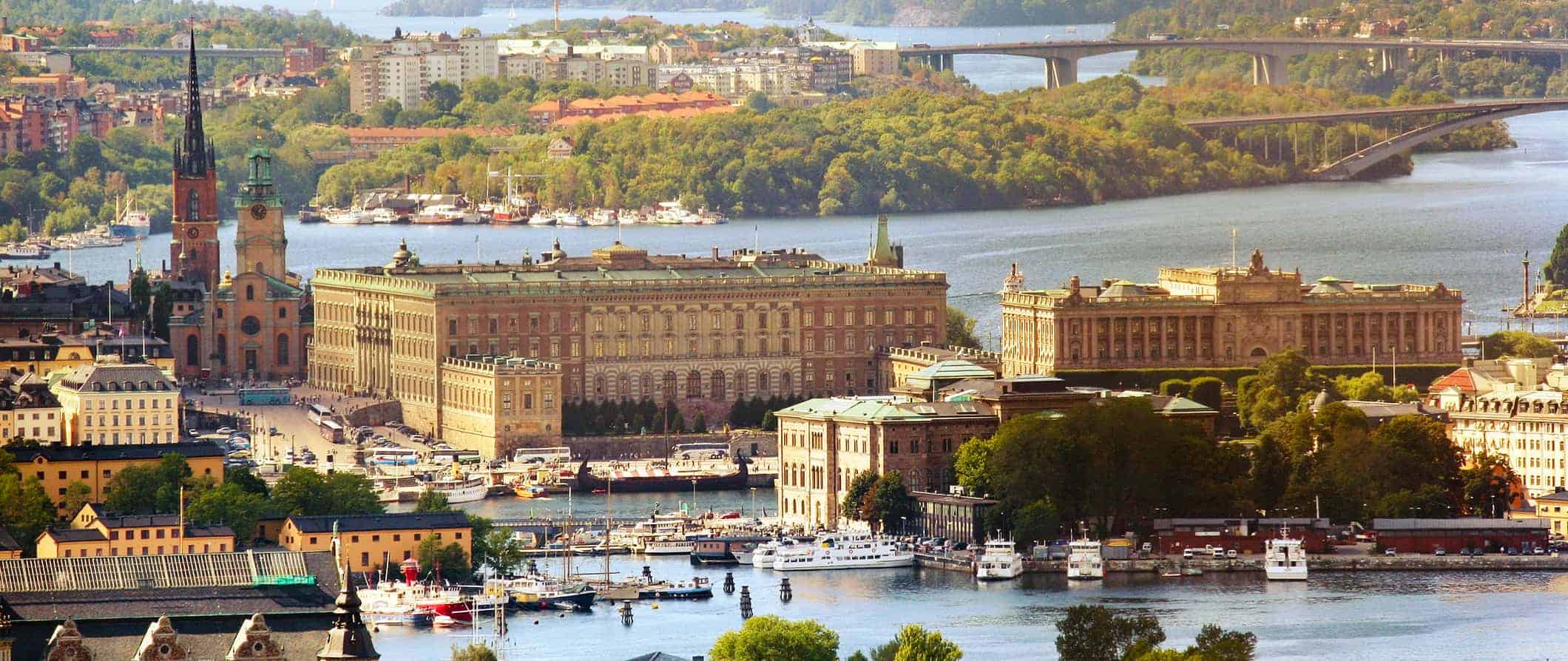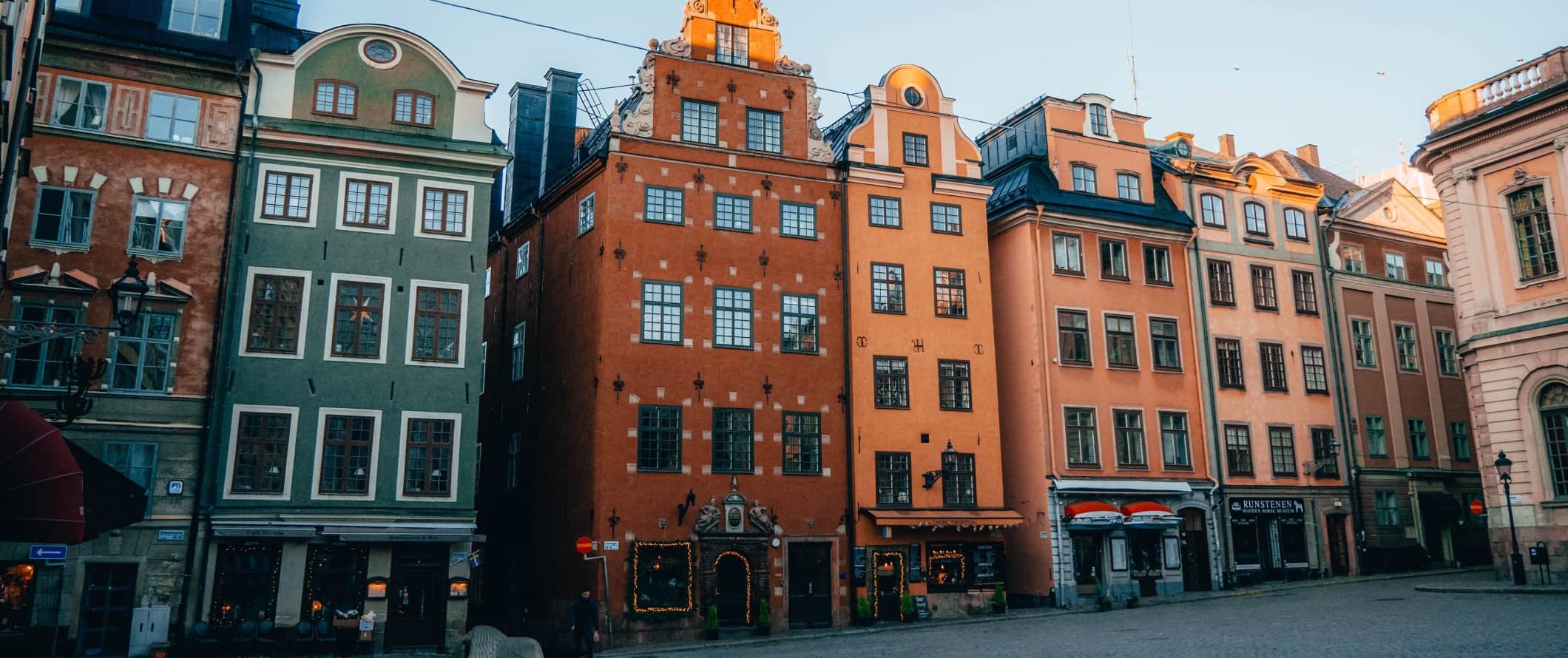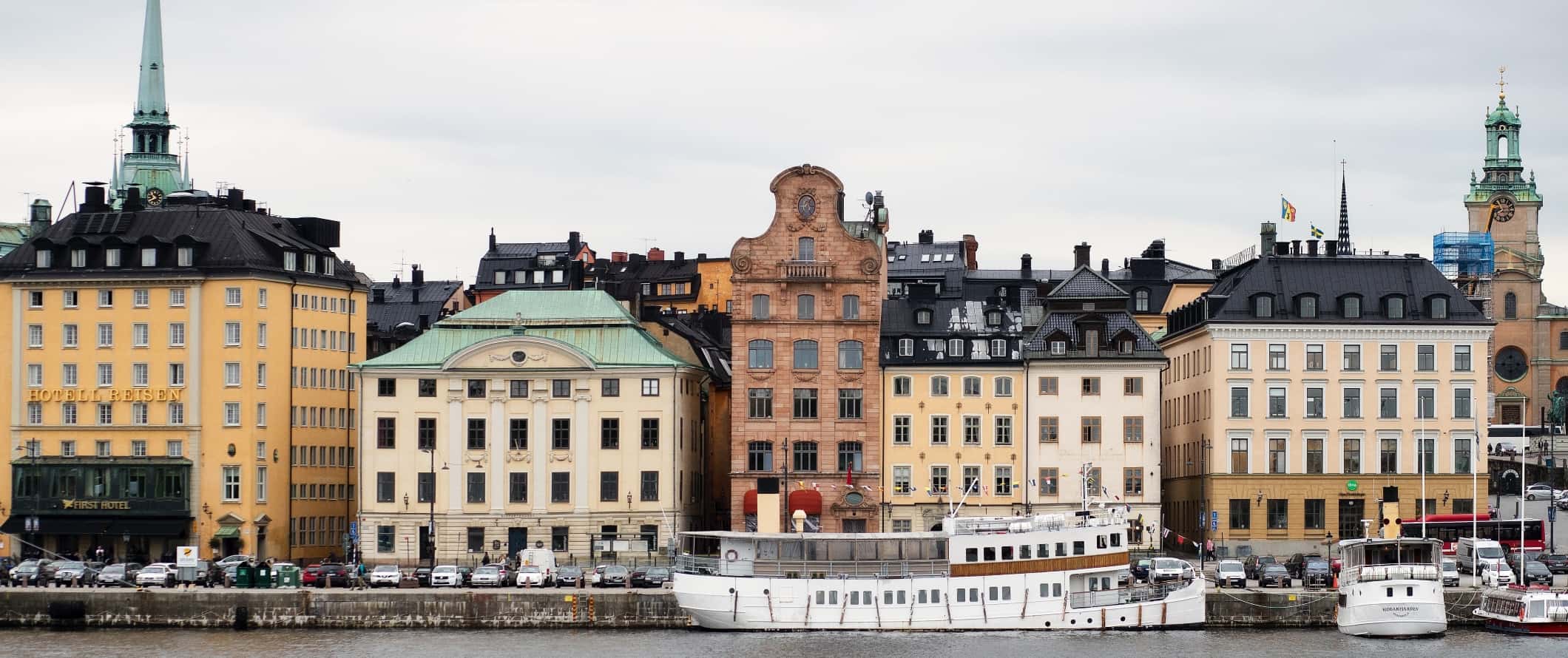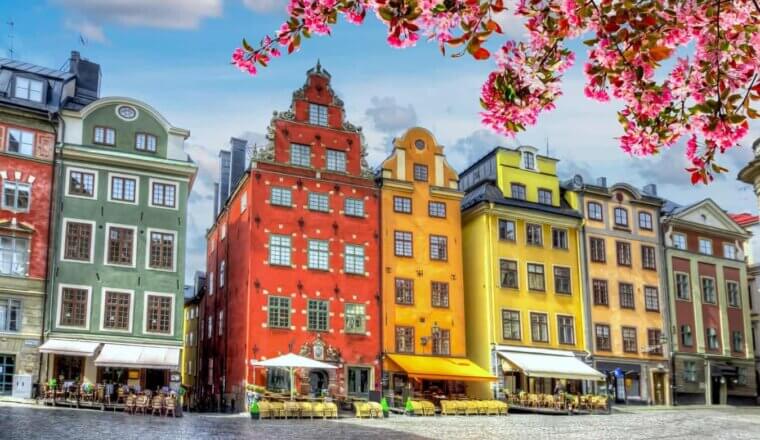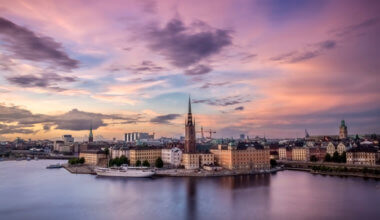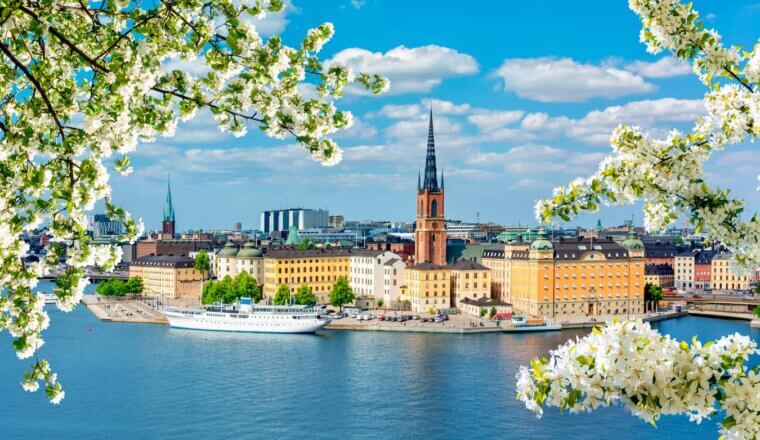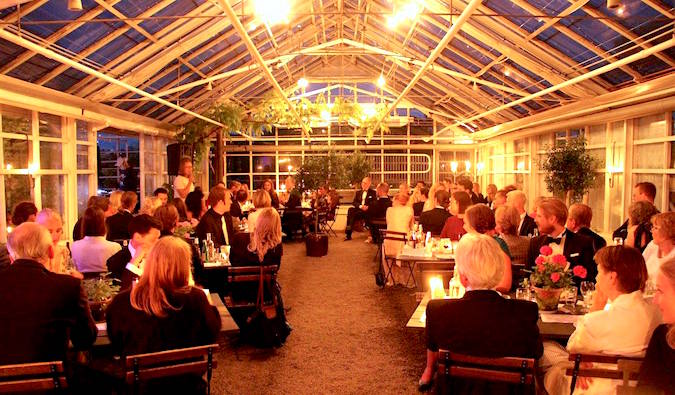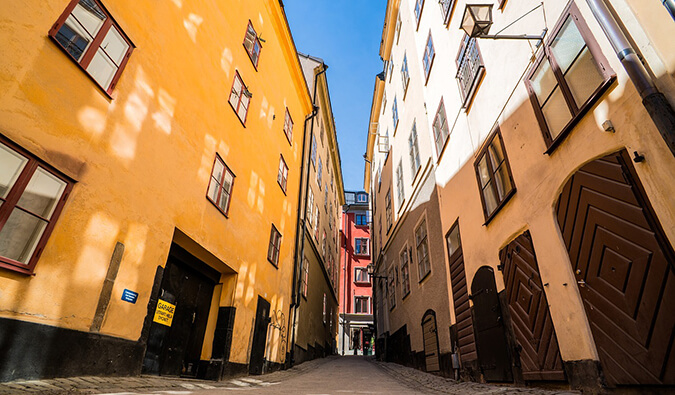Stockholm is one of the most beautiful cities in the world. No matter how often I come here, I am always amazed by it. Everything is just so photogenic and picturesque – the parks, the islands, the harbor, the historic colored houses dating back hundreds of years.
In fact, it’s so incredible that I even spent an entire summer living in the city!
Stockholm spreads itself out across fourteen islands (though there are thousands of islands in the archipelago) and has a ton of museums, attractions, parks, and art to see while getting lost among the historic streets and buildings. The people are wonderful too. While Swedes generally are quiet and reserved, they are happy to share advice with visitors.
Stockholm isn’t the cheapest place in the world so many backpackers rush their visit (or skip over the city entirely). That’s a mistake if you ask me as a visit here is worth every penny.
This travel guide to Stockholm can help you plan your trip, save money, and make the most of your visit to Sweden’s capital!
Table of Contents
Top 5 Things to See and Do in Stockholm
1. Walk around Gamla Stan
This is the oldest part of the city, with centuries-old buildings, the Nobel Museum, the Royal Palace, cobblestone streets, and the historic homes of the aristocracy. I never tire of wandering through it. Get here early in the summer to beat the crowds and have the narrow, winding alleys to yourself.
2. Wander around Skansen
Skansen was the first open-air museum in the world. It’s also a zoological garden specializing in Nordic fauna, such as moose, reindeer, bear, wolf, lynx, and wolverine. Entry is 160-220 SEK depending on the season.
3. Tour the archipelago
Stockholm is surrounded by beautiful islands and waterways. You haven’t really seen the city if you haven’t explored the archipelago. The good tours take a full day, going out to more secluded islands. Tours only operate during the summer. Or take the ferry and island hop yourself!
4. Enjoy fika
Each day, Swedes pause to have a coffee (or tea) and a baked treat. This daily ritual is called fika. For Swedes, fika (or “to fika”) is a normal part of everyday life and can be done wherever you want, with friends or solo.
5. Tour the Vasa Museum
This museum houses the world’s only preserved 17th-century ship. The Vasa was so poorly built that it sank a mile from the dock. The cold sea preserved the ship and the museum does a wonderful job of putting the ship into its historical context. Admission is 170-190 SEK.
Other Things to See and Do in Stockholm
1. Spend the day at Djurgarden Island
Djurgarden is an island right in the middle of Stockholm. You can take a walking tour, eat at a relaxing restaurant, enjoy the amusement park located here, and visit a historic Swedish village. There are a lot of easy walking paths and it’s a popular spot for a picnic. In the summer, it’s a wonderful place for people watching or lounging with a book.
2. Take a bike tour
To explore all the city’s neighborhoods, rent a bike or treat yourself to a guided bike tour of the city. The city is not traffic-heavy and the winding streets are so much fun to explore on wheels. Expect to pay around 200-250 SEK per day for a rental while guided bike tours range from 200-400 SEK per person.
3. Enjoy Stockholm’s wild nightlife
Stockholm is known for its nightclubs and bars. It may be expensive, but Swedes love to go out and party. Hit the clubs and party with the locals. Watch out for the blackjack tables (they have them at every club!). My favorite places to go out at night are Debaser Hornstulls Strand, Anchor, Retro, Under Bron, Rose, and Soap Bar. The main nightlife area is called Stureplan. Expect to pay 100-260 SEK per club just in entrance fees!
4. Tour the Royal Palace
Built between 1697-1760 and located on the east side of the Old Town, the Royal Palace is a Baroque palace open to the public. It’s one of the must-see sights in Stockholm. The building dominates Gamla Stan. The royal family doesn’t live here anymore, but it’s still an important historical site. A combined ticket to visit the treasury, reception rooms, and museum costs 140 SEK. The palace is closed when dignitaries are being hosted.
5. See the art at the National Museum
The National Museum was founded in 1792 and contains works by Rembrandt, Rubens, Goya, Renoir, Degas, and Gauguin, as well as well-known Swedish artists such as Carl Larsson, Ernst Josephson, C.F. Hill, and Anders Zorn. The collection is quite robust, especially if you like Scandinavian artists. Admission is free, though temporary exhibitions cost 70-170 SEK.
6. Explore the Medieval Museum
Located underneath the Royal Palace, this museum is one of the better history museums in the city. The museum was built around excavated monuments and sections of the city wall so you can actually see and experience what the city was like 400 years ago. There’s also a medieval graveyard here and a warship from the middle ages. You learn a lot of details about medieval Sweden and life in Stockholm. It’s free too!
7. Tour city hall
Built in 1911, Stockholm’s City Hall is a historic brick building that features daily guided tours for 110 SEK. You’ll see the official areas of the hall and learn about the history of the building and local government. You can also go up the tower from May-September (for an additional 50 SEK) for amazing views of Gamla Stan and the city. Tours go through the areas where official council business takes place, as well as the ceremonial halls used for official city events and banquets.
8. Walk along Monteliusvägen
This is a mile-long walking path that offers fantastic views of Lake Mälaren. It’s one of the best places in the city watch the sunset from too. I love coming here for a sunset stroll.
9. Visit Fotografiska
Fotografiska features some of the best works in contemporary photography. It’s only a couple of floors, but its rotating exhibits are always top-notch so I’m always happy to visit. There’s a bar and café on the top floor that offers panoramic views of the harbor and Gamla Stan. Admission is 165-245 SEK.
10. Visit the ABBA museum
A visit to Stockholm wouldn’t be complete without checking out the quirky ABBA museum. Tickets are not cheap (admission is 250 SEK) but it’s a colorful way to experience Sweden’s legendary pop group (they’re one of the most popular pop groups of all time, with some 150 million records sold). The museum displays their original costumes and outfits, gold records, and props from the Mamma Mia films (which were based on the music of ABBA). There are lots of interactive displays highlighting the history and achievements of the group too.
11. Visit the Swedish History Museum
If you’re interested in Scandinavian history, this museum covers the Stone Age to the Vikings. Highlights include the Gold Room, which houses gold treasures from the Bronze Age to the 16th century. It’s a very detailed museum and I think they do a really good job explaining their Viking history. Admission is free.
12. Day trip to Uppsala
It’s easy to day trip from Stockholm, so take the train to Uppsala and enjoy this university town’s abundance of quaint shops, beautiful parks, and waterways. There are several fantastic museums as well. Sigtuna is another great day trip option, especially for its preserved medieval buildings dating back to the 10th century.
13. Have fun at Gröna Lund Theme Park
This 15-acre amusement park has over 30 attractions and is a popular venue for concerts during the summer. Originally opened in 1883, the park is located on Djurgården so it’s easy to access. Just keep in mind that the schedule changes a lot so be sure to check the website before you go. Admission is 120 SEK.
14. See the stunning subway art
Stockholm’s subway system also doubles as the world’s longest art gallery. Since 1957, artists have been invited to decorate the subterranean stations with their work, and today over 90 out of 100 stations feature public art. Kungsträdgården is one of the most famous stations and features a colorful abstract garden complete with sculptures formerly housed at the palace.
15. Visit Drottningholm Palace
Located just 30 minutes outside of the city, this 17th-century palace is the most well-preserved in all of Sweden. Modeled after the Palace of Versailles, the UNESCO-listed complex includes ornate gardens, a theatre, a Chinese Pavilion, and elaborately decorated interiors. It is the official private residence of the Swedish royal family and is only open on weekends. Admission is 140 SEK or 170 SEK including a guided tour in English.
16. Stroll Strandvägen
Hugging the waterfront in the prestigious district of Östermalm, Strandvägen is a boulevard lined with beautiful Art Nouveau buildings on one side and floating bars and cafes on the other. Finished just in time for the Stockholm World’s Fair in 1897, the promenade remains a popular place to spend an afternoon.
17. Take a canal tour
There’s no better way to learn about this maritime city than by taking to the water. Join one of the many different canal tours showcasing different aspects and areas of the city. A 1-hour tour generally costs around 240 SEK.
For more information on other cities in Sweden, check out these guides:
Stockholm Travel Costs
Hostel prices – A bed in a 4-8-bed dorm room costs 200-260 SEK per night. For a private room, expect to pay at least 650 SEK per night. Most hostels in the city also add a 50-80 SEK surcharge for bed linen to offset the cost of cleaning (you are allowed to bring your own sheets, but sleeping bags are not permitted).
Fortunately, some of the hostels have some great perks. City Backpackers, for example, has a free sauna as well as free pasta while Skanstulls Hostel has free pasta, coffee, and tea. In expensive Sweden, free goes a long way to save money if you’re on a budget!
For those traveling with a tent, wild camping is legal outside the city. You just need to make sure you aren’t too close to someone’s house and are not camping in a cultivated field. But otherwise, Sweden’s Freedom to Roam law means you have a lot of leeway when it comes to wild camping.
Budget hotel prices – Budget hotels cost around 900 SEK per night. TV, free Wi-Fi, and coffee/tea makers are usually standard. Several hotels include free breakfast, so opt for these to save on your food budget.
Food – Food in Sweden is hearty and based heavily on meat, fish, and root vegetables. One of the most iconic and popular dishes is meatballs and a creamy sauce with potatoes and lingonberry jam. Crayfish, shrimp, mushrooms, and fresh summer berries are other popular staples. For breakfast, Swedes usually eat dark bread with cheese and vegetables. For fika, cinnamon buns are the go-to choice for many.
Like all of Sweden, eating out is expensive in Stockholm. You can get cheap food from outdoor street vendors starting at around 50 SEK, though these are few and far between. You can get hot dogs for around 30 SEK at places like 7-Eleven and Pressbyran.
Many convenience stores and cafes offer pre-packaged sandwiches and meals for 50-100 SEK if you’re on the go and want a quick bite. Whole pizzas cost around 65-95 SEK and most nice sit-down restaurant meals begin at 200 SEK for a main dish (for yummy pizza, check out Omnipollos Hatt).
If you’re looking for a drink, beer can be as cheap as 40 SEK, though 65-75 SEK is more common. Wine costs around 55-75 SEK at your average restaurant, and cocktails are around 100 SEK. If you’re on a budget and want to drink, stick to beer. You can buy your own alcohol at the government-run Systembolaget for even greater savings.
Some of my favorite places to eat are Herman’s, Omnipolls Hatt, Beijing8, Ramblas Tapas Bar, and Hattori Sushi Devil.
Grocery shopping costs around 600-700 SEK per week for basic groceries like pasta, rice, and veggies. However, if you cut down on your meat and cheese intake (some of the most expensive food items in Sweden) you can lower your costs significantly.
Backpacking Stockholm Suggested Budgets
On a backpacking budget, you should plan to spend 825 SEK per day. This is a suggested budget assuming you’re staying in a hostel dorm, cooking all your own meals, using public transportation, walking, limiting your drinking, and participating in free activities like visiting free museums and taking free walking tours.
On a mid-range of budget of 1,600 SEK per day, you can stay in private hostel rooms, get a public transportation pass and take the occasional Uber, eat some fast food, enjoy a couple drinks, and do some more paid activities like museum visits or a guided bike tour.
On a “luxury” budget of 2,330 SEK or more per day, you can stay in a budget hotel, eat out for all your meals, take taxis tog et around, drink more, do some excursions to the islands, and day trip to Uppsala. This is just the ground floor for luxury though. The sky is the limit!
Stockholm Travel Guide: Money-Saving Tips
Stockholm may not be the most budget-friendly city to visit, but luckily there are a lot of ways to save money. It’s not too hard to save big if you know just a few tips. Here is how to visit Stockholm on budget:
- Purchase the Go City Stockholm Card – This pass gives you access to the city’s public transportation system and free entrance into 99% of the museums and canal tours. It’s well worth the money and definitely saves a lot more than it costs if plan to do a lot of sightseeing. It includes access to over 60 attractions and is 669 SEK for a 1-day pass or 1,569 SEK for a 5-day pass (which is a much better deal!).
- Stay with locals for free – Accommodation is expensive in Stockholm. Consider using Couchsurfing, a site that connects travelers with locals who offer a free place to stay. If you can cut out your accommodation costs, you will save a lot of money. It’s also a great way to get to know the local culture because you’re staying in someone’s home and you can ask them all the questions you want.
- Free walking tours – Free Tour Stockholm runs the best walking tours in the city. They offer a few different tours, including a tour of Gamla Stan. They generally last two hours and are available in English. Just be sure to tip your guide at the end!
- Drink beer – If you are going to drink, stick to beer. It costs about half as much money as mixed drinks or wine at bars and restaurants. For greater savings, buy your own alcohol at the government-run Systembolaget (it can be up to 50% cheaper that way).
- Avoid the big restaurants – Eating out in Stockholm is very expensive. If you want to eat out, try to stick to the outside grills you see on the side of the street. You can find a variety in them and they are under 100 SEK per meal (which is half the price you’ll pay at a sit-down restaurant).
- Try the lunch buffets – If you choose to eat out, the lunch buffets are an economical way to do so, often costing around 110 SEK. They are a popular option with locals. For a healthier option, try Hermans or Hermitage.
- Get a metro card – If you don’t plan to get the Stockholm Card, make sure you get a week-long metro pass. At 415 SEK for a week of rides, it is a better deal than paying 160 SEK for just 24 hours.
- Avoid clubs – Most clubs have a cover charge of over 250 SEK. Don’t waste your money.
- Refill your water bottle – Water is about 30 SEK per bottle. Since the tap water is drinkable (one of the cleanest in Europe!) you should just buy one bottle and reuse it. Not only will this save you money, but it will save the environment too! My go-to bottle is LifeStraw since they have built-in filters to ensure your water is always clean and safe.
- Avoid the taxis – With the subway open late (or all night long depending on the day) you can avoid taking taxis. A typical ride costs more than 250 SEK, so avoid them at all costs! (Uber is cheaper than taxis but it’s still very expensive).
Where to Stay in Stockholm
Stockholm has lots of hostels and they’re all pretty comfortable and sociable. These are my suggested and recommended places to stay in Stockholm:
- Archipelago Hostel Old Town
- Generator Stockholm
- City Backpackers
- Skanstull Stockholm
- Castanea Old Town Hostel
For more hostel suggestions be sure to check out my list of the best hostels in Stockholm. And, to find out exactly where in the city you should stay, here’s a post that breakdowns the best neighborhoods in Stockholm.
How to Get Around Stockholm
Public Transportation – Public transportation in Stockholm costs 38 SEK per ticket, making the day pass (or multi-day pass) your best choice.
You need to purchase a reloadable card in advance or download the app. Cards cost 20 SEK and can be filled with as much credit as you need (including multi-day passes). A week-long pass is the best deal at 415 SEK, though you can also get a 24-hour pass for 160 SEK or a 72-hour pass for 315 SEK. These can be used on buses, ferries, and trains.
The subway is known as the tunnelbana (or T-bana). Subway trains operate 5am–1am on weekdays and all night on Fridays and Saturdays. Trains come every 10 minutes during the day and every 30 minutes at night.
When coming from Arlanda airport, the bus is your cheapest option. Flygbussarna runs shuttles regularly, with tickets costing 119 SEK (one way). The journey takes around 45 minutes.
You can also take the Arlanda Express train to Stockholm’s central train station. It’s 299 SEK for a one-way ticket. The journey takes around 20 minutes.
Taxi – Most cabs cost around 285 SEK and should be avoided as the trains and buses run all night. Avoid taxis unless you have no other choice as they will burn a hole in your budget!
Ridesharing – Uber here is a little cheaper than taxis but it’s still quite expensive. I don’t recommend using it unless you have to.
Bicycle – Stockholm is a very easy city to bike around. Many hostels rent bikes or organize bike tours. Rentals cost around 200-250 SEK per day and guided bike tours range from 300-400 SEK per person.
Car rental – Car rentals are expensive at 275 SEK per day. They’re unnecessary in the city, so I would only recommend getting one if you want to explore the surrounding region. Even then, you probably won’t need one as public transportation is so extensive in Sweden.
When to Go to Stockholm
The ideal time to visit Sweden is from June to August, when the weather is warm and the days are (really) long. Stockholm is at its liveliest during this time, with locals taking advantage of the good weather at every opportunity. The parks are always full, and there are always fun events happening around town. Temperatures are often in the 20s Celsius (60s and 70s Fahrenheit) during the summer.
The downside to visiting then is that, since Sweden has a very short summer, the city is rather crowded, so be sure to book your accommodation in advance. This is especially true if you are visiting during Midsommar, the big Swedish holiday at the end of June. It’s a great time to experience Swedish traditions (which involve a lot of drinking).
May typically has great weather with occasional rain, while September has cooler temperatures and changing leaves. You’ll beat the crowds and still be able to explore the city on foot without the weather getting in your way (too much).
Attractions begin to close around late September, and the days get dark early in October. Temperatures start dropping around this time too. However, prices also decrease, and you’re likely to find cheaper airfares and accommodations during this time. Be sure to pack layers if you plan on visiting during this time of year.
The winter is very cold and sees a lot of snow and darkness. In the depths of the winter, you only get a few hours of light each day and temperatures plummet below -0ºC (32ºF). The plus side of traveling during the off-season, however, is that you can get the cheapest accommodations, and fees for certain attractions will be lower as well. While Stockholm is quite beautiful in winter, you won’t want to be walking around as much, and since it’s a great city to explore on foot, you will potentially be missing out.
How to Stay Safe in Stockholm
Sweden is one of the safest countries in the world. In fact, it ranks 15th on the ranking of the world’s safest countries (for comparison, the USA is 122nd) it’s a great destination for solo travelers — including solo female travelers.
However, Stockholm is still a large city, so the standard precautions apply (never leave your drink unattended at the bar, never walk home alone intoxicated, etc.). Keep an eye out for pickpockets, especially around the train stations and on public transportation.
As in any city, be aware of your surroundings and use common sense and you should be just fine. You’re not really going to find any scams in the city either. It’s pretty safe.
That said, always keep an eye on your drink when out at the bar and never walk home alone if intoxicated.
If you’re worried about getting ripped off, here’s a list of common travel scams to avoid.
If you do experience an emergency, dial 112 for assistance.
Always trust your gut instinct. Make copies of your personal documents, including your passport and ID. Forward your itinerary along to loved ones so they’ll know where you are.
The most important piece of advice I can offer is to purchase travel insurance. Travel insurance will protect you against illness, injury, theft, and cancellations. It’s comprehensive protection in case anything goes wrong. I never go on a trip without it as I’ve had to use it many times in the past.
Stockholm Travel Guide: The Best Booking Resources
These are my favorite companies to use when I travel. They consistently have the best deals, offer world-class customer service and great value, and overall, are better than their competitors. They are the companies I use the most and are always the starting point in my search for travel deals.
- Skyscanner – Skyscanner is my favorite flight search engine. They search small websites and budget airlines that larger search sites tend to miss. They are hands down the number one place to start.
- Hostelworld – This is the best hostel accommodation site out there with the largest inventory, best search interface, and widest availability.
- Booking.com – The best all around booking site that constantly provides the cheapest and lowest rates. They have the widest selection of budget accommodation. In all my tests, they’ve always had the cheapest rates out of all the booking websites.
- HostelPass – This new card gives you up to 20% off hostels throughout Europe. It’s a great way to save money. They’re constantly adding new hostels too. I’ve always wanted something like this and glad it finallt exists.
- Get Your Guide – Get Your Guide is a huge online marketplace for tours and excursions. They have tons of tour options available in cities all around the world, including everything from cooking classes, walking tours, street art lessons, and more!
- The Man in Seat 61 – This website is the ultimate guide to train travel anywhere in the world. They have the most comprehensive information on routes, times, prices, and train conditions. If you are planning a long train journey or some epic train trip, consult this site.
- Rome2Rio – This website allows you to see how to get from point A to point B the best and cheapest way possible. It will give you all the bus, train, plane, or boat routes that can get you there as well as how much they cost.
- FlixBus – Flixbus has routes between 20 European countries with prices starting as low 5 EUR! Their buses include WiFi, electrical outlets, a free checked bag.
- SafetyWing – Safety Wing offers convenient and affordable plans tailored to digital nomads and long-term travelers. They have cheap monthly plans, great customer service, and an easy-to-use claims process that makes it perfect for those on the road.
- LifeStraw – My go-to company for reusable water bottles with built-in filters so you can ensure your drinking water is always clean and safe.
- Unbound Merino – They make lightweight, durable, easy-to-clean travel clothing.
- Top Travel Credit Cards – Points are the best way to cut down travel expenses. Here’s my favorite point earning credit cards so you can get free travel!
Stockholm Travel Guide: Related Articles
Want more info? Check out all the articles I’ve written on backpacking/traveling Sweden and continue planning your trip:
